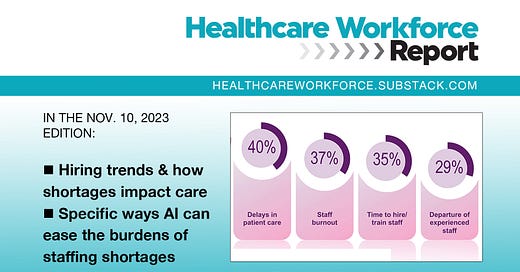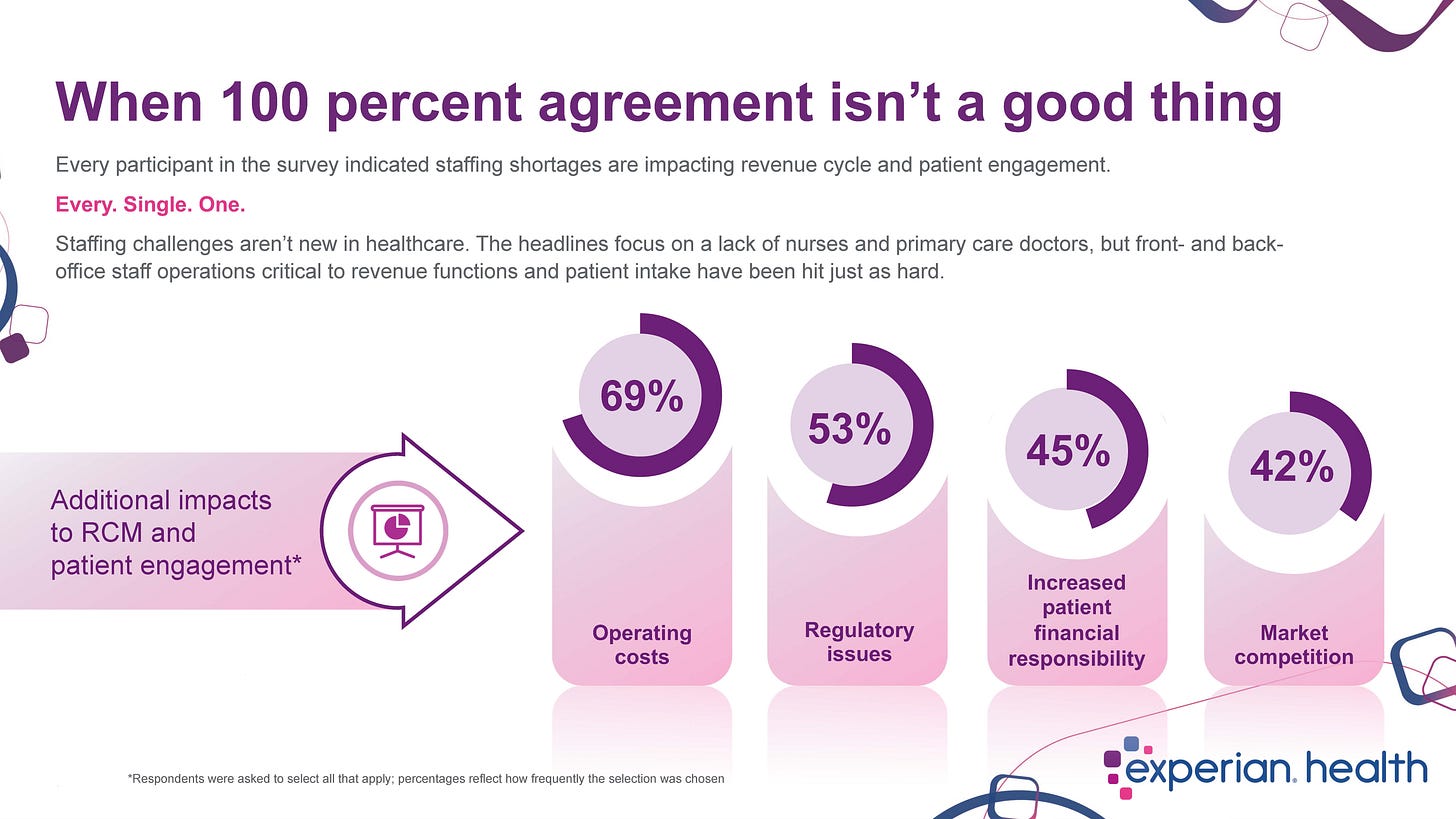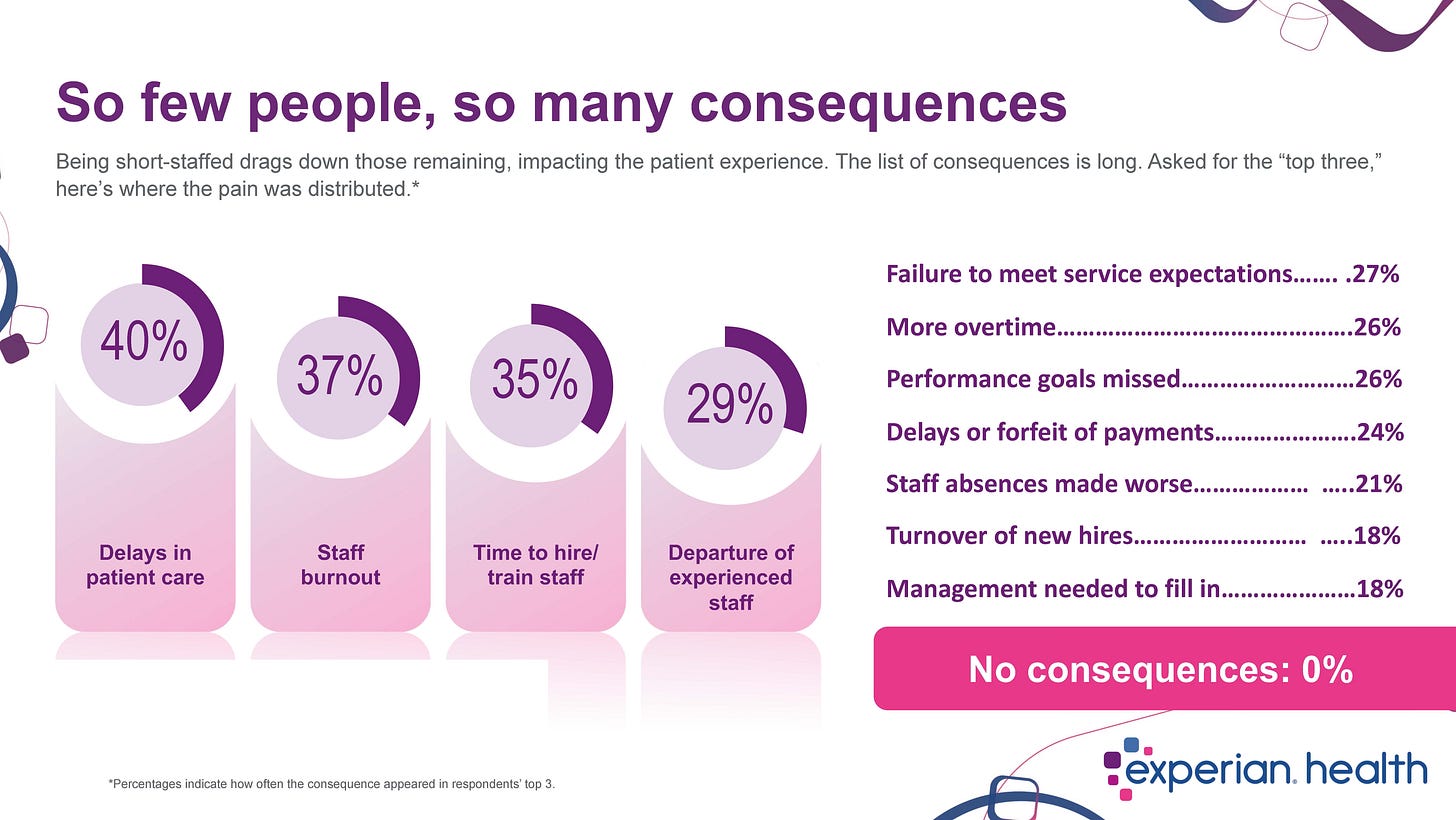An innovative workforce solution that starts in public high schools
Plus: Hiring keeps rising; telehealth funding hike; HC orgs detail how shortages are impacting RCM and patient care; and how to use AI to ease staffing shortage burdens
Lots of great stuff this week, but first, the latest Labor data: Healthcare hiring grew more in October than it has all year, even as the nation’s overall job growth slowed.
Healthcare created 58K new jobs in October, led by ambulatory care services (32K), hospitals (18K), and nursing/residential care (8K).
Becker’s Hospital Review breaks down the trends, noting that employers are starting to see results from their efforts to improve retention and fill vacancies — though many many healthcare jobs remain open.
“This is not to say that hospitals and health systems are not facing shortages of workers,” Kelly Gooch at Becker’s writes. ”But there are notable hiring efforts. Both Renton, Wash.-based Providence and Rochester, Minn.-based Mayo Clinic also recently reported record years for hiring.
“At Providence, 33,000 positions had been filled this year as of September, about 19,000 of which were filled by external candidates,” the report says. “This represents a 15% increase in total fills and a 23% increase in external hires compared with 2022. Providence has also seen close to a 20% increase in retention.”
More federal funds, extended access to telehealth
Becker’s reports on the Biden administration’s news that it is seeking ways to better support rural healthcare providers’ use of telehealth services, and the proposed 2024 budget includes about $45M for telehealth services.
Additionally, the temporary pandemic rules allowing Medicare and Medicaid to reimburse for telehealth visits are being extended through Dec. 31, 2024.
Research: Staffing shortages are hurting revenue and patient engagement
New research from Experian Health on the impact to healthcare employers of ongoing workforce shortages, based on a survey of hospital and health system executives, finds that every respondent said shortages “have significantly affected revenue cycle management and patient engagement efforts,” HITconsultant.net reports.
“While staffing challenges persist, the majority of respondents prefer to shore up human resource approaches rather than leveraging technology such as automation and artificial intelligence to address staffing issues,” the report says.
90% reported double-digit turnover rates for administrative roles related to patient access, RCM, and the patient experience.
80% said staffing shortages have “worsened the patient experience” in the following ways:
Delays in patient care (40%)
Patient arrival and registration
Appointment scheduling
Prior authorization approval
Insurance coverage confirmation
Patient estimates
Nearly half reported turnover rates of over 25%, significantly higher than the U.S. average.
How healthcare employers who responded are addressing retention challenges:
46% increasing salaries
44% cross-training
42% boosting incentives
Only 25% of respondents said they “are considering consolidating workstreams across processes,” and just 27% said they are “exploring the use of integrated artificial intelligence (AI) to improve efficiency.”
Speaking of AI: A CNO explains how it could ‘reinvent nurse staffing’
This article by Danielle Bowie, Chief Nursing Officer at Trusted Health, is a great resource for HC executives: “Where AI can have the greatest impact” breaks down the “5 key staffing practices that are particularly poised for disruption” by AI technology.
Compensation
Scheduling
Recruiting
Performance
Retention
Bowie offers specific examples of tech that is available now and how it can ease the burdens of staffing shortages for healthcare organizations.
“Larger hospitals and multi-facility healthcare systems often have massive amounts of data to sort through, which means they can benefit from AI’s ability to streamline staffing practices across many departments or sites of care,” she writes.
“AI can help them reduce manual labor, automate basic processes, and create far-reaching efficiencies. Conversely, rural facilities or those in underserved areas are often stretched thin on time and resources and face a particularly high barrier when it comes to nurse recruitment and staffing. AI can aid in addressing these challenges by predicting demand, optimizing resource allocation, and minimizing unnecessary spending.”
Innovation: Healthcare training in high schools opens doors for employers and students
Did you know that public school Career and Technical Education centers all over the country are in high demand?
As the cost of a four-year degree has risen and high-schoolers’ willingness to borrow for college has fallen, CTE programs offered through school districts are a hot commodity, with many reports of students on waiting lists.
In most states, high schools get a limited number of “seats” in a regional CTE program, which is usually off-campus. The demand for trained workers in STEM fields has a lot of CTE programs bursting at the seams.
Enter Emerge Education, a Pennsylvania-based workforce and education consulting nonprofit, and online training and credentials platform MedCerts (the sponsor of this newsletter).
MedCerts and Emerge recently unveiled a new program — piloted over the last two years with 900 students — that allows high-schoolers at Cumberland Valley School District to participate in a new kind of CTE program that doesn’t require a “seat” at their regional CTE campus.
Students at CVHS who are not college bound are already in the program and on track to graduate high school with an industry-recognized credential, career-ready skills for healthcare jobs — and they earn college credits with the certification, too, in case they decide to go to college later in their career.
The MedCerts Healthcare Training Program for high schools includes online training provided by MedCerts, which offers college credits for its healthcare and IT CTE programs from seven higher education institutions.
The cost per student is the same or less than a typical CTE per-student cost is, Emerge told me for this report I wrote for THEJournal.com. It is the same cost that an individual would pay for the same online certification course taken independently, or about $4,000. But in this MedCerts program with Emerge, that cost for a high school student to participate includes hands-on training with a local healthcare employer.
The school doesn’t have to hire any new staff to offer the program, though a guidance counselor is needed to usher students into and through the program and support them through passing their certification exam.
“Emerge is in early planning stages with a couple dozen other school districts wanting to offer MedCerts’ healthcare courses to their students,” Emerge’s Lauren Holubec told THEJournal.com. She expects them to be in high demand once word spreads about the program’s inaugural class at Cumberland Valley.
“We're creating the exemplar because we're doing what employers are asking for: giving high school students a way to earn verified credentials that are career-ready and stackable or transferable for future career growth through higher education,” Holubec said.”
Check out the full report at THEJournal.com.
Shout-out to Healthcare Workforce Report sponsors
The Healthcare Workforce Report newsletter is generously supported by MedCerts.
For information on supporting HWR, email HealthcareWorkforce@substack.com.







